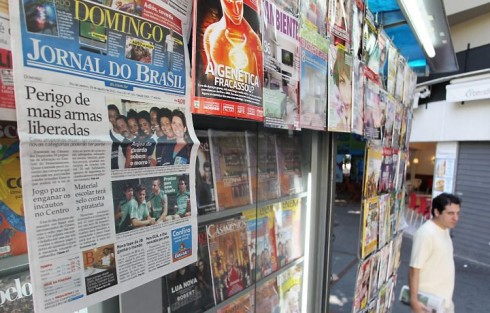strong>TAKEAWAY: It is one of Brazil’s most traditional newspapers, but after 119 years of publishing, Jornal do Brasil has abandoned its printed edition to become an online newspaper only. The shape of things to come? Not for everyone, for sure, but one of the models we will see in place.
“Always an innovator”

Image contributed by our reader Alexandre Linhares Giesbrecht: last edition of JB in print, as seen in the press kiosk—-photo by Márcia Foletto/O Globo


Images from JB Digital: subscribers can flip through screens to read the newspaper online
Much has been written about Jornal do Brasil in the past 72 hours.
On Sept. 1, the legendary Brazilian daily abandoned ink on paper to become an “online newspaper” only. The newspaper that in its glory days sold about 150,000 copies a day was now seeling a mere 21,000. If you go online, you will find that the newspaper is now branded as JB Digital. It also promotes itself as “the first Brazilian newspaper on the Internet,” a true claim which some bloggers tie to the innovative spirit of JB, forecasting that perhaps this, the first Brazilian daily to go totally digital may signal the way of things to come for other newspapers in the country. One blogger wrote: “Jornal do Brasil has always been a true innovator, could it be that this is also another form of setting the trend for the rest of us?”.
For me, personally, Jornal do Brasil brings the memories of my first consulting work in Brazil. It was 1979 and I was invited by then publisher (and a member of the family that owned JB) , Jose do Nacimiento Brito, to come “take a look at our newspaper and see how we could make it look better”. I entered the JB building and was impressed by the activity, the effervescence, and the quality of the illustrators who created marvelous caricatures and illustrations as fast as they could down those little cups of strong Brazilian coffee. It was not a full scale redesign, mostly an organization of typographic scheme, a remodeling of the front page and the creation of a more “poster like” front page for the Lifestyle and Entertainment section.
As I read what account to obituaries for JB I see the irony of the situation: columnists mourn the “death” of JB, although, in fact, the newspaper continues, but on a different platform. One columnist described JB’s history as ” a century of glory and two decades of agony”.
If you ask me, I think this is one of at least three modes of operation we will see in the next five years for newspapers worldwide.
1. The printed newspaper as part of multiplatform: this will be the most usual mode, in my view. The newspaper will adapt and will change role dramatically, but without ceasing to print. As in the case of the Detroit Free Press, we will see printing of the newspaper on some days of the week, not others.
2. The printed newspaper as part of a weekend package only. This is what The Christian Science Monitor has done: ink on paper only for weekends, and a daily online edition.
3. The online/tablet newspaper: in this model, chosen by Jornal do Brasil, we see no printed product at all, but publication continues digitally only.
The spirit and journalistic tradition of Jornal do Brasil are still here. I refuse to think that this is the way all newspapers will end. Not at all, but it will be one of the options that publishers facing hard times will have. It is not a solution that will work for all——and, indeed, not for many, I am sure.
One of our readers in Brazil, Alexandre Linhares Giesbrecht, wrote me the following reminiscence about JB:
In 1994, when I started following newspapers more closely, I bought JB at least once a week for a few months. It really looked dated for the times. Its printing was way behind the others, with very few color pages, and those color pages printed really poorly. That was my only regular contact with the paper. The only other impression I got from it was the curious way they used photo credits: they didn’t limit it to the author and/or agency; they added the city where the picture was taken. I don’t know if they still did it in 2010, but at least in 2002 they did.
Read more (in Portuguese):
http://oglobo.globo.com/economia/mat/2010/08/31/o-adeus-ao-jornal-do-brasil-apos-119-anos-um-dos-diarios-mais-importantes-do-pais-deixa-de-existir-na-sua-versao-em-papel-917524544.asp
The Mario Blog post #622